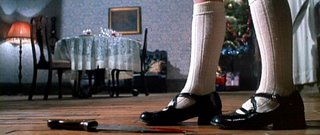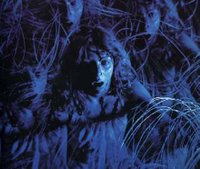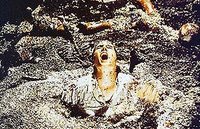Petri Dish 101: Dario Argento, Horror Cinema's Most Gifted Savant

Some of the most flawless, seamless so-called cinema masterpieces evaporate from the mind the instant you finish watching 'em. But there are certain filmmakers who can nail you to the edge of your seat during even their lesser efforts. Dario Argento, for me at least, is one of those directors.
I've always thought of Argento as a bit of an artistic savant--goofy script tangents and cardboard characterizations pepper nearly all of his films. If you don't take a glass-half-full stance with a lot of his work, you could get irritated. If you don't have a tolerance for extremely strong onscreen violence, you could get nauseated. So why bother watching any of his movies?
Because--warts and all--he's one of modern horror cinema's greatest visual stylists. No, scratch that: He's one of modern cinemas greatest visual stylists, period. Warts, absurdities, and all.
At their best, the Italian director's movies bypass rational explanation and imbed themselves directly into the viewer's cerebellum, capturing the syntax and structure (or lack thereof) inherent in the most disturbing and compelling nightmares. He's one of the few filmmakers who can make a virtue out of barely-controlled anarchy: Argento's movies don't always make literal sense, but like all good horror films (and all good nightmares), they make total sense to your subconscious. Subtlety knows no place in Dario Argento's universe: his films, saturated with blood and violence (only Sam Peckinpah rivals the Italian maestro in his ability to turn graphic death into a sickening-yet-beautiful cinematic ballet), bathed in color, abuzz with fluid Steadicam work, and rife with noise, are all about sensory overload of the most magnificent order.
Argento took the torch held by other seminal figures of Italian horror cinema like Mario Bava and Antonio Margheriti, then ran with it, influencing thrillers well into the twenty-first century. If you've seen Seven, or The Silence of the Lambs, or any one of a hundred gruesome serial killer thrillers, you've seen a more literal version of what Dario Argento has been doing for thirty-plus years.
This progeny of a prominent film producer father and a fashion-model mother began showing interest in film from an early age, writing for a major Italian film journal while he was still in high school. By age twenty he was cutting his teeth as a screenwriter in Italy, penning scripts for several action flicks and westerns; most significantly, he received a story credit fo Sergio Leone's Once Upon a Time in the West.
His directorial debut, 1969's The Bird with the Crystal Plumage, was a huge international hit, and a new horror subgenre was born. The movie drew inspiration from the pulp mystery novels that crowded European bookstores for decades, and these books sported yellow pages, so the term 'giallo' (the Italian word for yellow) stuck.
On its surface, The Bird with the Crystal Plumage's plot couldn't be more routine. It details a classic cliche storyline of a man who witnesses a woman being assaulted in an art gallery in Rome, only to be stalked by the assailant (and, soon, murderer) himself. But Argento's prowling camera and incredible, balletically-staged suspense set pieces signaled the arrival of a promising cinema stylist. Scores of other Italian directors followed suit, regurgitating the formula with mixed results. Most of the films made in this sub-genre proved to be indifferent to insufferable, but Dario Argento's efforts proved that if they're well-done (wait for it, folks...), there's always room for Giallo.
Argento has put out films steadily since, but his most fertile creative period stretched for about ten years, from 1975 to 1985. During this time his directorial eye was at its most feverishly imaginative. He subverted and transcended the Giallo genre he helped create, and injected heavy doses of lysergic fantasy and crackpot eccentricity into his finest works. The films that Dario Argento directed during his creative peak changed horror cinema, and they still pulse with dark magic. You'll note that I don't do a lot of blathering about each of these films; simply put, verbal descriptions can never come near doing Argento's film's justice.
Essential Argento:
Deep Red (1975): During an exhibition of her powers, a psychic accidentally reads the thoughts of a killer in a crowded lecture hall. She's murdered soon after in a bloody pas-des-deux that's witnessed by a jazz pianist (David Hemmings).
 Argento's gracefully gliding camera and artfully staged scenes of carnage receive immeasureable aid from one of his tightest scripts (co-written by Fellini co-scripter Bernardino Zapponi); there's a definite pattern and method to all of the subtle visual clues and swatches of audio-visual symbolism that the director lays out, making Deep Red a satisfying repeat view.
Argento's gracefully gliding camera and artfully staged scenes of carnage receive immeasureable aid from one of his tightest scripts (co-written by Fellini co-scripter Bernardino Zapponi); there's a definite pattern and method to all of the subtle visual clues and swatches of audio-visual symbolism that the director lays out, making Deep Red a satisfying repeat view.Suspiria (1977):
 Widely regarded as Argento's masterpiece, and I'm inclined to agree. As per usual, the plot--young woman (Jessica Harper) attends a ballet academy that may or may not be run by a coven of witches--could fit on the head of a pin, but Suspiria's dazzling color scheme, layers of atmosphere, and nerve-jangling Goblin score combine to create a fairy tale of ravishing dark richness. Love it or hate it, you will never forget it.
Widely regarded as Argento's masterpiece, and I'm inclined to agree. As per usual, the plot--young woman (Jessica Harper) attends a ballet academy that may or may not be run by a coven of witches--could fit on the head of a pin, but Suspiria's dazzling color scheme, layers of atmosphere, and nerve-jangling Goblin score combine to create a fairy tale of ravishing dark richness. Love it or hate it, you will never forget it. Inferno (1980): Even more disjointed (and a bit less satisfying) than Suspiria, this informal sequel nonetheless includes some of Argento's most arrestingly bizarre setpieces, including an underwater sequence stolen by Neil Jordan for his unsuccessful Argento knock-off, In Dreams.
Inferno (1980): Even more disjointed (and a bit less satisfying) than Suspiria, this informal sequel nonetheless includes some of Argento's most arrestingly bizarre setpieces, including an underwater sequence stolen by Neil Jordan for his unsuccessful Argento knock-off, In Dreams.Tenebrae (1982): Silly but undeniably effective, Tenebrae covers the misadventures of a famous horror author (Tony Franciosa) as horrific killings from his books start happening in real life. The script here, again, is cobblers, but some of Argento's most ferociously imaginative mayhem lies within (there's a lengthy and continuous Steadicam shot about twenty minutes in that'll flat-out take your breath away). The solid-but-usually underused Franciosa gets to flex some acting muscle here in the movie's climactic moments, and Argento rates beaucoup bonus points just for hiring John Saxon to play Franciosa's agent.
Phenomena (1985): Suspiria may be widely touted as Dario Argento's finest directorial hour, but this chiller comes incredibly close to these eyes. Jennifer Connelly plays a withdrawn young woman attending a private girls' school in Switzerland. She's an abject outcast to her fellow students,
 but her telepathic kinship with insects makes her a valuable--and endangered--tool in solving a series of gruesome murders. Argento's at his wildest--the hero is a straight-razor-wielding chimpanzee, folks--but his knack for suspense is in full flower. He somehow makes the placid and gorgeous Swiss countryside into an intensely forboding backdrop during the bravura opening scene. And the surrogate daughter-father relationship between Connelly and kindly investigative scientist McGregor (a customarily terrific Donald Pleasance) gives Phenomena something really shocking; namely, a heart.
but her telepathic kinship with insects makes her a valuable--and endangered--tool in solving a series of gruesome murders. Argento's at his wildest--the hero is a straight-razor-wielding chimpanzee, folks--but his knack for suspense is in full flower. He somehow makes the placid and gorgeous Swiss countryside into an intensely forboding backdrop during the bravura opening scene. And the surrogate daughter-father relationship between Connelly and kindly investigative scientist McGregor (a customarily terrific Donald Pleasance) gives Phenomena something really shocking; namely, a heart.Opera (1987): A young soprano with an Italian opera company is stalked and terrorized by a psychopath during an avant-garde production of Verdi's Macbeth. Opera marks the beginning of Argento's creative atrophy: where his films up to this point boasted characters who navigated on nightmare logic, in Opera they're just irritating and ill-motivated most of the time. That said, there's style to burn here, with a phenomenal opening scene that conveys the bustle and grandeur of a grand opera rehearsal nicely, several phenomenal bouts of amped-up suspense, and one of the maestro's most influential death setpieces (this time involving a gun, not a knife or sharp object, surprisingly enough).


Comments